
9 minute read
WONDERS OF THE WEALD




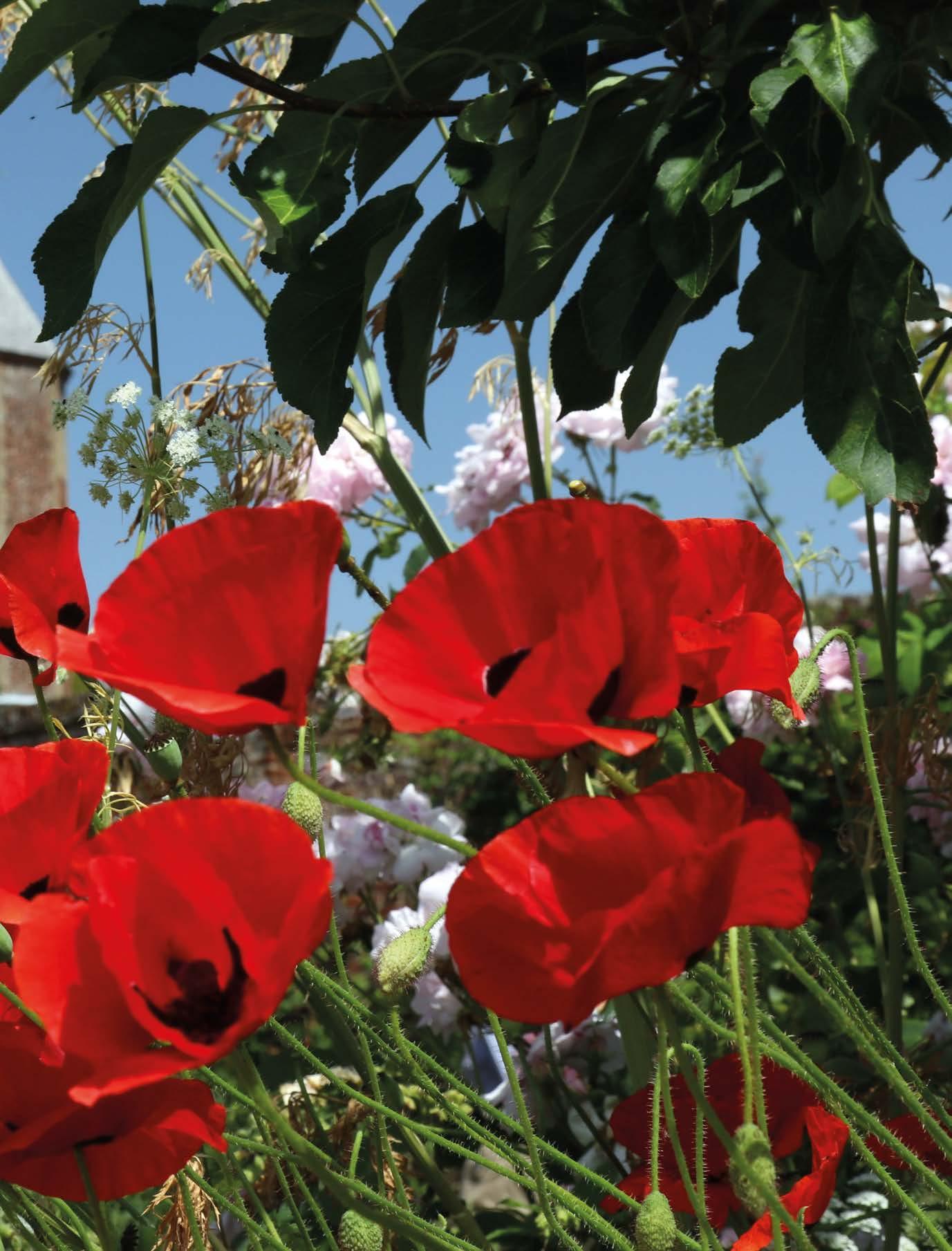
A sunny swathe of Kent and Sussex, so little changed over the centuries, harbours some of the country’s finest gardens
WORDS NATASHA FOGES
Right: Sissinghurst's Cottage Garden in bloom in April Below: The moated Scotney Castle
Picture a quintessentially English landscape and it probably looks much like the slice of southeastern England known as the High Weald. This Area of Outstanding Natural Beauty presents a timeless ensemble of wooded hills, sunken country lanes and magical villages dotted with Tudor manors, medieval churches and the red-brick oast houses that once held kilns for drying hops.
It was Henry VIII who first crowned Kent ‘the Garden of England’. The High Weald, spanning 560 square miles across Kent and neighbouring Sussex, has long been renowned for its horticultural wonders. Nurtured by a warm and sunny microclimate and fertile soil, an extraordinary number of beautiful gardens bloom here, tucked away down ancient country lanes.
First stop for any dedicated garden enthusiast should be Sissinghurst. When the author Vita Sackville-West and her husband Sir Harold Nicolson bought this plot in the heart of the Weald in 1930, it was “a garden crying out for rescue”, a weed-strewn wasteland filled with “old bedsteads, old cabbage stalks…and mountains of old sardine tins”. Over the course of thirty years they turned this derelict five-acre plot into one of the finest gardens in England.
A tall tower of pale-pink brick at the garden’s heart is all that remains of a grand Tudor mansion fit for a queen (Elizabeth I was a former guest). At first sight, Vita was captivated by the structure – which had, centuries earlier, held captive thousands of French sailors, prisoners of the British in the Seven Years War (1756-63). A harsh place, it was grimly nicknamed ‘le chateau’. The name stuck and the garden that, little by little, grew around it became Sissinghurst Castle Garden.
Laid out as a series of diverse ‘rooms’, the garden marries Vita’s love of tumbling, romantic displays with her husband’s fondness for order and geometry. The celebrated Rose Garden, which Vita envisaged “foaming” with blooms, is all delicate romance, while the magical White Garden, with its frothy Queen Anne’s lace and silvery weeping pear, is a cool contrast to the fiery hues of the Cottage Garden.
From Sissinghurst, make the short detour to Cranbrook, a tiny town that is improbably known as ‘the Capital of the Weald’; its parish church, St Dunstan’s, is ‘the Cathedral of the Weald’. The town’s pretty streets hold listed buildings, quaint shops and the Union Windmill, open to the public on summer afternoons.
From here it’s a few miles to romantic Scotney Castle, whose medieval ruin encircled by a moat stands at the heart of a rambling garden. It is the essence of a fairytale castle tower, especially when veiled in white wisteria in
MICHAEL A HILL © NATIONAL TRUST IMAGES/JO HATCHER/ANDREW BUTLER/LOOK/ROBERT HARDING/HEINZ WOHNER ILLUSTRATION: © PHOTOS:

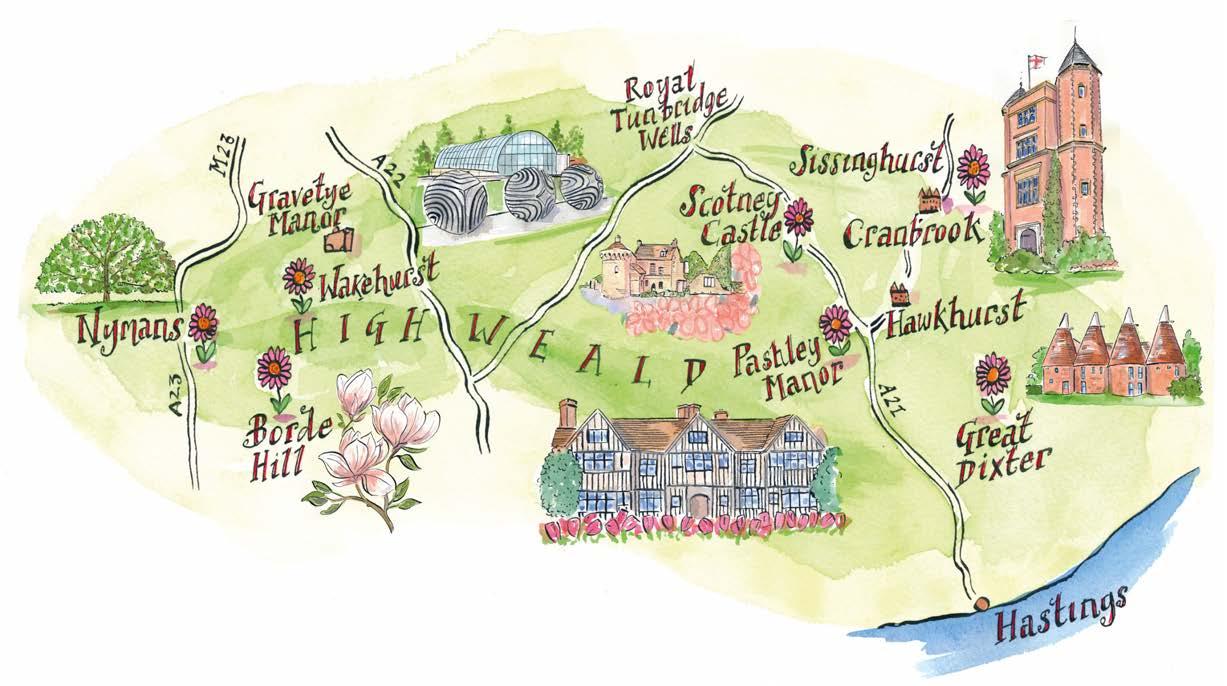
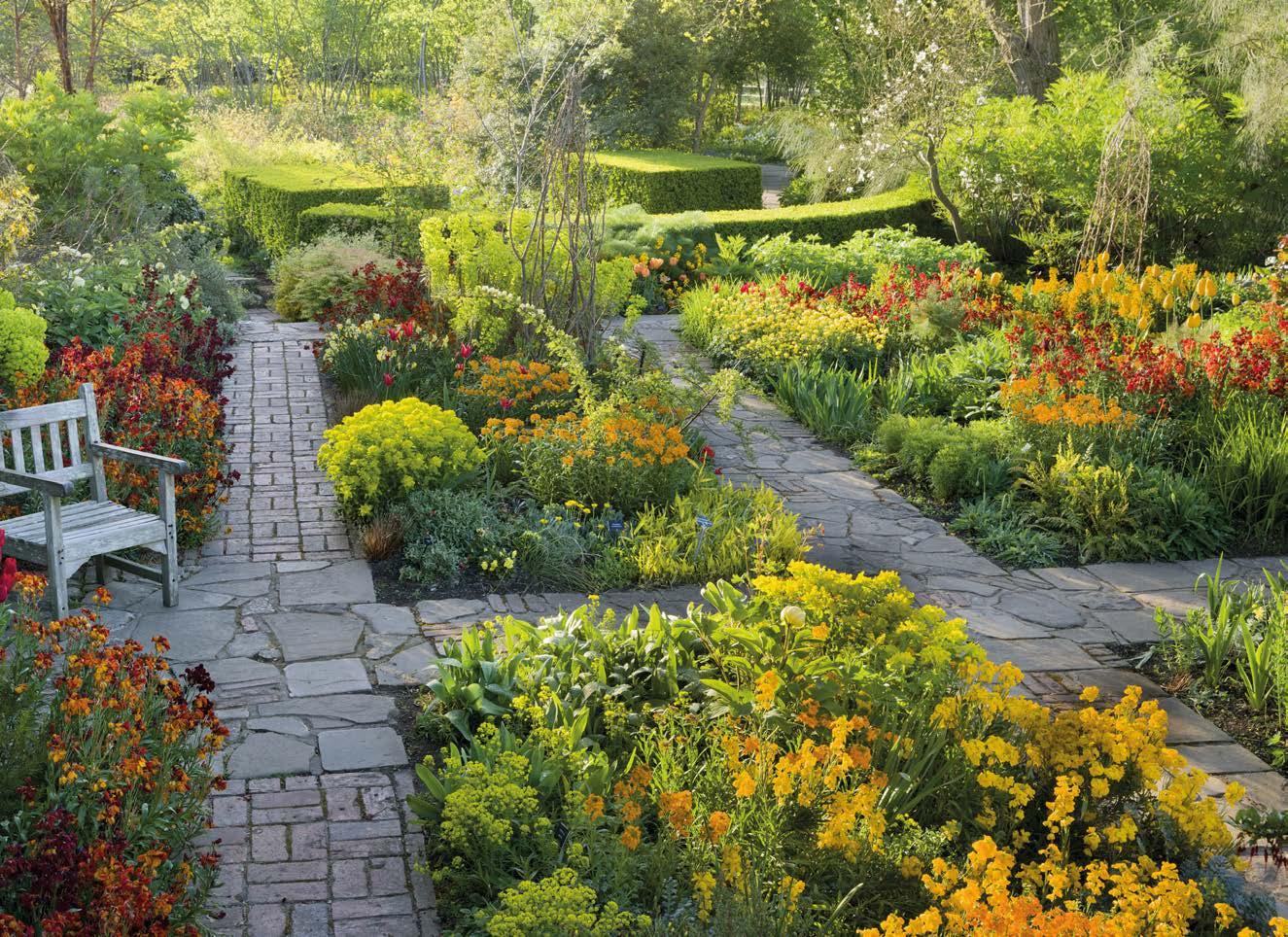
Clockwise from this image: The ruins of Hastings Castle; the Long Border and Manor at Great Dixter; cobbled streets in Rye

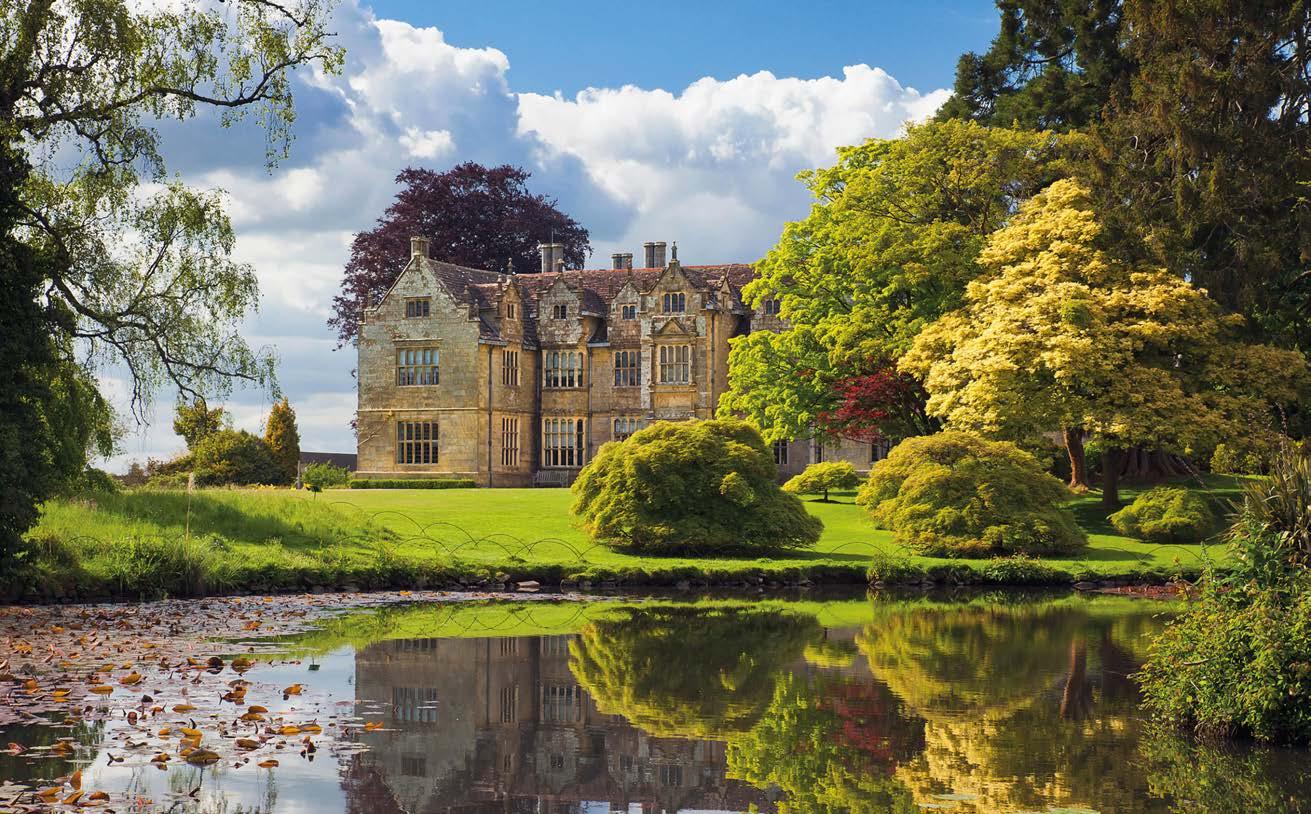
springtime. A priest hole hidden within its walls dates back to the 16th century, when the castle was owned by the Catholic Darrell family, who secretly harboured a priest here for seven years when anti-Catholic feeling was at its height.
In 1778 Edward Hussey bought Scotney from the Darrells and reimagined the garden in the newly fashionable ‘picturesque’ style. He even carefully ‘ruined’ the dilapidated castle even further to fulfil his dreamily romantic vision. This might seem like sacrilege, but glimpse its crumbling turret through cloud-like masses of rhododendrons and azaleas and you might just forgive him.
A few miles drive south, passing through the crossroads village of Hawkhurst – once ruled by the notorious Hawkhurst Gang, who ran a thuggish trade in blackmarket tea and rum in the mid-18th century – you arrive at one of England’s most famous gardens.
Serious gardeners speak about Great Dixter in tones of hushed reverence. It is the creation – and life’s work – of the late gardener and journalist Christopher Lloyd, who returned to the house, his childhood home, in 1950 after studying horticulture. Keen to question the sometimes precious world of gardening, he eschewed long-held ‘rules’ and practices in favour of experimental pairings and unexpected twists.
Disappointed with his crop of roses one year, for example, Lloyd replaced the rose garden – hirtherto a must for any self-respecting English country garden – with a planting of lush exotics, proving that plants such as dahlias and the Japanese banana could extend the flowering time of a English country garden well into the autumn.
Even those not attuned to the garden’s innovative idiosyncrasies will appreciate its luxuriant borders and technicolour plantings. Lloyd pioneered the idea of the mixed border, and Great Dixter’s puts on a dazzling display from April to October, with the 15th-century manor house, adapted in 1910 by the architect Edwin Lutyens, providing the perfect backdrop.
Tucked away nearby, down a quiet country lane, is wisteria-covered Pashley Manor, another handsome Tudor house brought to life by glorious blooms. The gardens are a labour of love for owners James and Angela Sellick, who have tended and transformed them over the course of 30 years. Visit in the spring for the Tulip Festival, an annual extravaganza that sees some 43,000 tulips of all varieties and colours emerge in all their glory.
The house, usually closed to the public, has an intriguing historical connection: Anne Boleyn, Henry VIII’s unfortunate second wife, is thought to have spent parts of her childhood here, as her family used it as a hunting lodge. A statue of Anne stands on the moated island; her ghost, it is said, haunts the manor still.
Further west, across the Kent border into Sussex, Wakehurst is the rural outpost of London’s Kew Gardens. Less manicured than its city sister, it has a sprawling 500 acres of woodland and the Millennium Seed Bank, a collection of over 2.4 billion seeds from around the world, housed in sub-zero underground chambers to conserve them for the future: a botanical Noah’s Ark.
Visitors can also roam a Southern Hemisphere Garden, a Himalayan Glade and an Asian Heath Garden, and plans are afoot to create an American prairie. Nearby Borde Hill Garden exchanges Wakehurst’s wild and sweeping spaces with peaceful, intimate garden ‘rooms’ and bucolic Wealden views. A secret-garden atmosphere prevails as you wander from the tranquil Italian Garden – a lily pond framed by geranium-filled terracotta pots and pink pelargoniums – to the romantic ruins of the Old Potting Sheds and the Rose Garden, bursting with David Austin roses.
Beyond, woodland dells are scattered with rare trees, many of which are ‘champions’ planted in the early 20th century by Colonel Stephenson R Clarke. The Colonel bought the Elizabethan mansion at the heart of the gardens in 1893 and sponsored the great plant-hunters
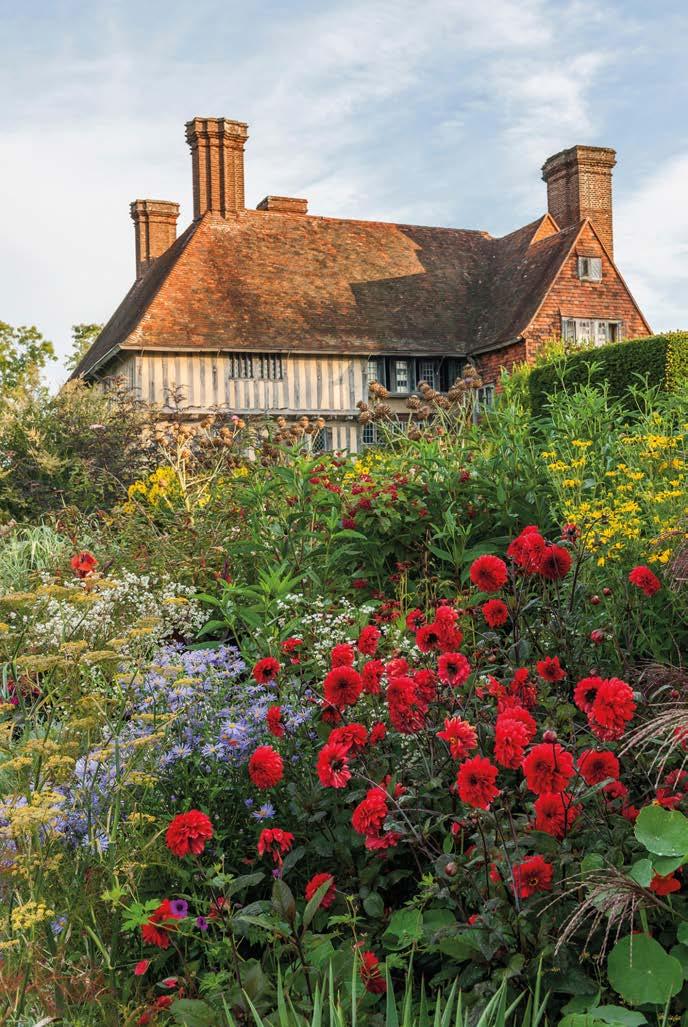
Clockwise, from above: The Long Border at Great Dixter; the Elizabethan Mansion at Wakehurst now belongs to the National Trust; the Rose Garden at Borde Hill in the summer
This image: The manor house ruins at Nymans Below: Wisteria and tulips in bloom at Pashley Manor

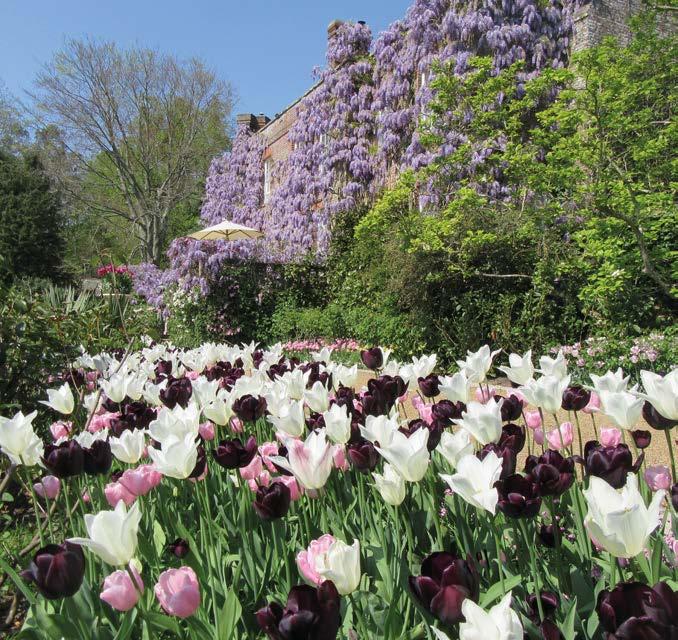
THE PLANNER
GETTING THERE AND AROUND All of the gardens are less than an hour from London by train, then a short taxi ride; see the individual gardens’ websites for information.
Seeing multiple gardens is easiest on a self-drive tour, perhaps over the course of two or three days. Alternatively, there are tour companies that will organise the transport and accommodation for you and guide you around, including Brightwater Holidays, Flora Garden Tours and Classic England. www.thetrainline.com; www.brightwaterholidays.com; www.flora-garden-tours.com; www.classic-england.com
WHERE TO STAY AND EAT Gravetye Manor is the perfect hotel for garden enthusiasts, with historic gardens created by William Robinson in 1885 and luxurious country-house-style rooms. The Michelin-starred restaurant uses produce from the hotel’s kitchen garden in dishes such as Creedy Carver duck with lavender, honey and parsnip. www.gravetyemanor.co.uk
i
FURTHER INFORMATION www.highweald.org
to travel all over the world in search of new and exotic specimens. Four generations of his family have looked after the 200-acre estate since.
The fearless Edwardian plant-hunters also supplied Nymans, where our tour concludes, with rare exotics. Look out for the Handkerchief Tree, draped with unusual white ‘flowers’ in May. It was collected from a cliff edge in China in 1901 by Ernest Wilson, plant-hunter to the aristocracy. Though shipwrecked on his way home, Wilson managed to hold onto the precious seeds and fulfil his mission. No wonder the tree was once considered the Holy Grail of exotic flora.
The estate was bought in 1890 by Ludwig Messel, a German Jewish émigré who had become a successful stockbroker. It was his son and heir Leonard who enhanced the garden’s horticultural value by sponsoring far-flung plant-hunting expeditions.
Leonard remodelled the Regency house at Nymans into a medieval-style manor, but it was partly destroyed by a catastrophic fire in 1947 on the night of his 75th birthday. When the National Trust bought it six years later it was left a ruin, its stage-set beauty the perfect foil for the naturalistic gardens that surround it.
The double border in the Walled Garden is at its exuberant best in midsummer, but quieter times of year – February for snowdrops, daffodils and crocuses, October for flaming foliage – can be equally rewarding. One of the most celebrated gardens of Edwardian England, it hasn’t lost its magic.
Below: The moated Herstmonceux Castle
The Rose Garden in June at Nymans

GARDEN HIGHLIGHTS
Sissinghurst The magnificent White Garden is at its peak in July, with an all-white display of gladioli, irises and pompom dahlias. www.nationaltrust.org.uk Scotney Castle Visit in spring to admire the view of the ruined castle through clouds of pink rhododendrons. www.nationaltrust.org.uk Great Dixter Highlight of this wonderful Arts and Crafts garden is its Long Border, bursting with colour throughout the summer. www.greatdixter.co.uk Pashley Manor Gardens Visit in late April or early May for the spectacular Tulip Festival, with tulips planted in themed garden ‘rooms’. www.pashleymanorgardens.com Wakehurst April and May see swathes of bluebells carpeting the woodlands at Wakehurst. www.kew.org/wakehurst Borde Hill Garden Visit in June or July to experience the Rose Garden at its sweetly scented best. www.bordehill.co.uk Nymans In February Nymans’ magnolia trees start to blossom, while the arboretum puts on a stunning display in the autumn. www.nationaltrust.org.uk





